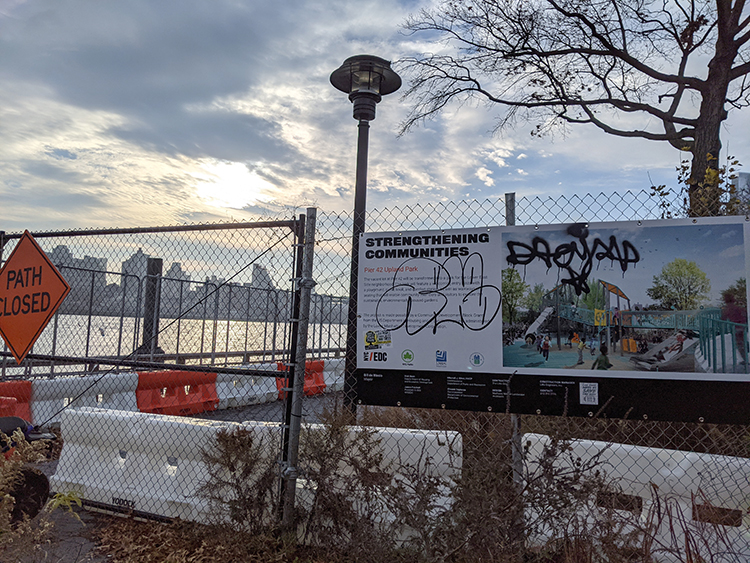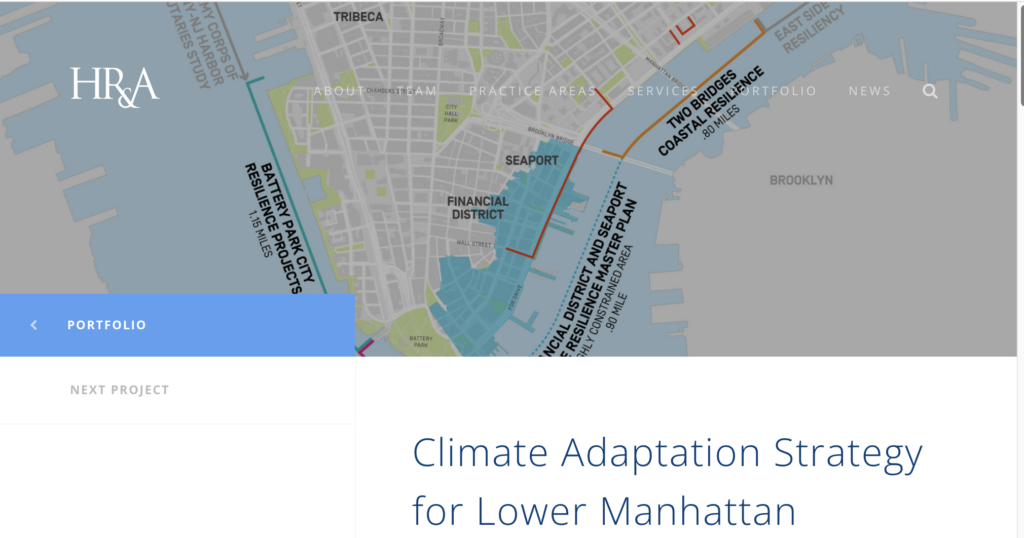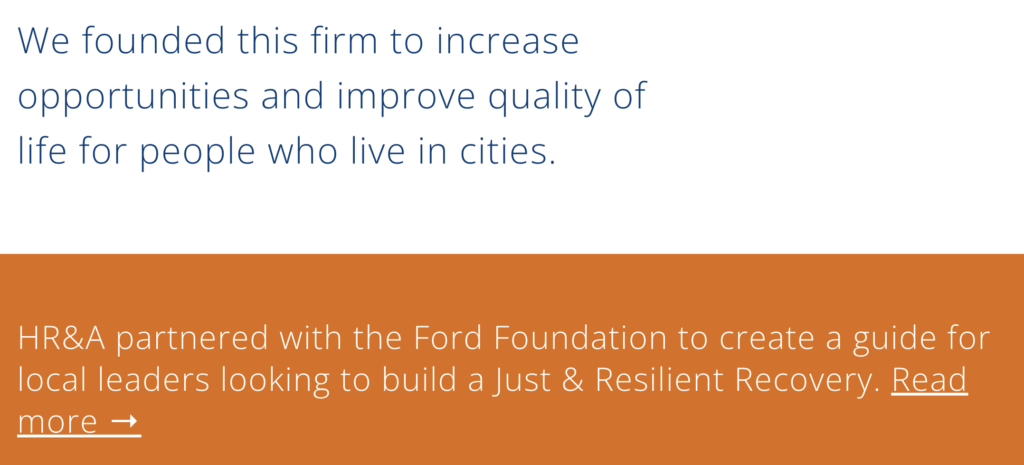
ABSTRACT
If one sets up a structure that is not democratic, it will result in community abuse and destruction, for that it is what it was set up to do. In this case, the sample I am studying is the destruction of the East River Park (also called the John V. Lindsay East River Park). This text follows on a previous text called The Family[1], which dealt with a lack of transparency and accountability in both the way The City of New York is advised on major real estate development and in the process through which it appoints officials in real state matters. This paper examines the threat inherent in the link between a systemic “set up” and its consequences in the everyday lives of people—in the air we breathe and in the disappearance of public space. Furthermore, this paper tackles a very common phenomena: the empty affirmation, which, in short, says the absolute opposite of what will be done. The “cynical discourse” in this case is the claim of resilient recovery for a beloved park that is being demolished before our eyes. This paper also analyzes how a foundation (reputed for giving and philanthropy) and a newspaper (purported to deliver the truth) shape public opinion by constructing false narratives.

The interests and agents behind The East Side Coastal Resiliency and the destruction of the East River Park:
1) On the New York City Government site one can read:
“The East Side Coastal Resiliency (ESCR) Project is a coastal protection initiative, jointly funded by the City of New York and the federal government, aimed at reducing flood risk due to coastal storms and sea level rise on Manhattan’s East Side from East 25th Street to Montgomery Street.”
https://www1.nyc.gov/site/escr/index.page
2) The East Side Coastal Resiliency Plan appears on the web site of a real estate company that is the solo advisor for the City: HR&A. HR&A called Climate Adaptation Strategy for Lower Manhattan:
“New York City, like many other coastal cities around the world, must face the realities of climate changes and its impact on the urban environment…. The New York City Economic Development Corporation and the New York City Mayor’s Office of Recovery and Resiliency engaged HR&A to co-lead a team that developed a strategic plan for Lower Manhattan as part of the Lower Manhattan Coastal Resiliency Study.”

3) This East Side Coastal Resiliency Plan has opposition from over 20,000 individuals living in the East River Park Community. Some of them created the East River Park Action. They say:
“Hurricane Sandy Didn’t Kill East River Park. New York City Is…The city is determined to go ahead with the massively destructive ESCR–East Side Coastal Resiliency project–even though there are alternatives that could preserve much of our park and provide flood control… New York City is demolishing our big, beloved park on the un-wealthy side of the Lower East Side and East Village…. We Need a Green Plan, Not an Environmental Disaster…True Resiliency is Possible. There are better plans that will preserve our park and give us flood protection. https://eastriverparkaction.org/
4) The East Side Coastal Resiliency Plan. $1.5 Billionwas created, most likely, at HR&A by Jamie Torres Springer before 2019, when he was an advisor, and then implemented by Springer when he moved to City Government to be the New York City Design Deputy and Commissioner from 2019 to 2021. Maria Torres Springer, wife of Jamie, was HPD commissioner and is now the vice president of the Ford Foundation. The Ford Foundation is in partnership with HR&A, and is creating a guide for local leaders regarding resilient recovery. Meanwhile they are destroying the East River Park and demolishing 1,000 trees.
5) The only advisor for development in New York City is HR&A.
“On January 13, 2015 the de Blasio administration ordered the Economic Development Corporation to “choose HR&A on a sole source basis.”
THE FAMILY Blog Civic Gaps,
This gesture presents multiple questions on how a democratic structure can be sustained when only one company advises on New York City development. Why has the Mayor appointed a single firm as consultant for the whole city? How does this benefit the Mayor? How does it affect the City of New York to have a real estate firm holding so much behind-the-scenes power?
6) In my paper The Family, on the blog Civic Gaps, I question the criteria used to appoint elected officials and I delineate the very tight relations between New York City and the real estate company HR&A:
“HR&A Advisors occupy or have occupied the most important positions in urban, city planning and housing in the City of New York: In the position of Commissioner of HPD Housing Preservation and Development in 2007 was Maria Torres Springer. Maria Torres Springer is the wife of Jamie Torres Springer, partner of HR&A Advisors. She was in office from February 2017 to March 2019.”
I also address the relationship between New York City and one real estate firm, HR&A. In the blog one can read these questions:
“Is there any benefit for HR&A Advisors to have former employees or employees relatives in most important positions in urban, city planning and housing in the City of New York? How does it affect New York residents to have a real estate firm making decisions on housing, city, and urban development?”
Common sense tells us that it is a conflict of interest to have a real estate firm making decisions on housing, city, and urban development, one of the conflicts being that their decision-making is based on profits from contracts and not the well-being of the communities. A real estate firm making decisions on housing, city, and urban development results in the loss of public space. In this case, it is resulting in the destruction of the East River Park—the only green space available in the LES community—and the loss of over 1,000 trees.
7) Mayor de Blasio Announces Resiliency Plan to Protect Lower Manhattan From Climate Change on March 14, 2019. He said:
“…. Taken together, these elements mean that more traditional on-land flood protection measures are not feasible. Ultimately, the Study found that extending the shoreline into the East River is the only feasible way to protect these vulnerable and vital parts of the city.”

8) Following the East River Park Action, this plan does not “protect these vulnerable and vital parts of the city” but quite the opposite—it destroys them:
“New York City is demolishing our big, beloved park on the unwealthy side of the Lower East Side and East Village. Everything must go—shady lawns, picnic areas, ballfields, running track, amphitheater, the compost yard, historic buildings, and 1,000 trees.”
9) Why is this happening? Why destroy trees? Is there a hidden agenda behind the removal of trees and the eradication of a park? An agenda that might be beneficial for certain agents involved in the destruction process? And who are these agents?
The interests of HR&A may contradict the public interest because HR&A is a real estate company: “this firm might advise perhaps not what is better for the common good but what is better for them since HR&A Advisors, Inc. (HR&A) is an industry-leading consulting firm providing services in real estate, economic development, and program design & implementation.”
Most likely, Jamie Torres Springer first drafted the plan while at HR&A and then, by becoming commissioner of the New York City Department of Design and Construction (DDC), was in a position to choose who would be contracted to do this $1.5 billion job.
The technical explanations of the project don’t mention any of the behind-the-scene realities.
But what appears to be behind this project are the following agents: The de Blasio administration, HR&A, and The Ford Foundation, and specifically two individuals as protagonists: Jamie Torres Springer and his wife, Maria Torres Springer.
Here you can see Jamie Torres Springer presenting the project: https://www.amny.com/news/ddc-and-nyc-parks-department-showcases-east-river-park-resiliency-construction/

10) Jamie Torres-Springer, ex-partner of HR&A Advisors, stepped out of the Firm and into the Agency as Deputy Commissioner in August 2018 (Maria Torres Springer stepped out as HPD Commissioner in early March 2019) and he was named the new commissioner of the New York City Department of Design and Construction (DDC) in March 2021. He left the that job in November 2021, right before the project was launched (“City to Start East Side Coastal Resiliency Construction in East River Park (New York, NY – November 1, 2021)” https://www1.nyc.gov/site/ddc/about/press-releases/2021/pr-110121-ESCR-construction.page
This movement from the private firm to the government might be profitable in the following ways:
- HR&A gets paid to advise
- HR&A gets to influence decision making in the City of New York, which could result in opportunities to purchase land on the cheap or to set conditions advantageous for developers seeking to buy NYC property.
- Once out of HR&A and in a position of power in the City government one can issue contracts, selecting those companies that are going to execute the construction, and favoring certain companies over others.
11) Linkedin profiles of Maria Torres-Springer and Jaime Torres-Springer
https://www.linkedin.com/in/maria-torres-springer-892920175/


https://www.linkedin.com/in/jamie-torres-springer-b017984/
12) Empty Affirmation and the Cynical Discourse: saying the absolute opposite of doing. In this instance, the Cynical Discourse trumpets a resilient recovery when in fact a beloved park is being demolished. The destroyers make themselves out to be “do-gooders.”
Right now there is a sign in HR&A that reads:
“HR&A partnered with the Ford Foundation to create a guide for local leaders looking to build a Just & Resilient Recovery.”

Maria Torres Springer, former HPD commissioner and the wife of former senior employee at HR&A (Jamie Torres Springer) is now Vice President of the US Programs at Ford Foundation. In About Ford, one reads:
“We believe in the
inherent dignity of all people. But around the world, too many people are
excluded from the political, economic, and social institutions that shape their
lives. Across eight decades, our mission has sought to reduce poverty and
injustice, strengthen democratic values, promote international cooperation, and
advance human achievement.”
https://www.fordfoundation.org/about/about-ford/
To not take into account the voices of 20,000 individuals who signed a petition against the East Side Coastal Resiliency Plan, doesn´t look like a good way to “strengthen democratic values.”
Somewhere in the Ford Foundation site one can reads:
“We have created or helped sustain thousands of pathbreaking organizations working on a broad range of social change issues.”
Right now, by supporting HR&A, the creator of the East Side Coastal Resiliency Plan, the Ford Foundation is acting against its mission of supporting pathbreaking organizations on social change.
What does an association with HR&A bring to the Ford Foundation and its legacy? The Ford Foundation becomes known for cutting down trees.
13) There is a long history of HR&A employees inserting themselves into the boards of not-for-profits. With the purpose of giving itself a wholesome image, HR&A allied itself with the Center for Urban Future, Design Trust For Public Space, and now the Ford Foundation. In this way HR&A hides its predatory practices and ethic of gentrification. Drafting a New York that is designed for the wealthy, it masquerades as a do-gooder.
14) There are other instances of HR&A destroying public buildings and public spaces:
Jamie Torres Springer is named as “the developer in connection with the long-secret and no-bid Sunset Park Library leaves.” They call him the “Library-Shrinking Developer”—the developer who shrinks libraries.
http://citizensdefendinglibraries.blogspot.com/2016/11/

15) There is another park that has something in common with the East River Park, in that both developers are connected to HR&A.
“John H. Alschuler serves as chairman of the High Line park. In his day job, he is chairman of HR&A Advisors, which pulled in a cool $1.3 million lobbying fee for its efforts to plop that stadium in Flushing Meadows. Javier Valdes is a director of Make the Road New York, a nonprofit group that works to empower the hundreds of thousands of working-class and poor residents of Queens. The group expects to fight for paid sick days and better wages. It does not expect to battle to preserve the little green space available to the densely packed neighborhoods. The Rev. Darrell DaCosta, pastor of St. Paul the Apostle Catholic Church in Corona, has a congregation whose work weeks are arduous. They are drawn as if by homing beacon to the park. ‘It’s in a natural setting that you learn the value of God’s creation,’ he notes. ‘Everything in New York can’t be bought and sold. … We call this park the pulmones of Queens, the lungs of the city,’ he says. ‘Why are we giving our land away to an oil tycoon?’”
Park Deals Chip Away at City’s Gems
16) The Civic Gaps blog The Family traces the circumstances in which Maria Torres Springer became HPD Commissioner:
An article by Sally Goldenberg, published on January 17, 2017 on www.politico.com, reads: “In a phone interview Monday, Alicia Glen said she opted to elevate her aides, rather than conduct a broader search for Been’s replacement, because of uncertainty facing the city’s housing plan under the incoming Trump administration. ‘You always want to look at the family first, and if there’s great people in the family and people like James, [who] demonstrated [his] ability to step up, you want to reward those people,’ she said. … Maria Torres Springer, beyond being the wife of Jamie Torres Springer didn’t have major experience.”
The text asks one simple question: Is “being part of the family” the right criteria to select government officials?
The relationship of trust between the government and the people is deteriorated in general in the world, but this is an important problem in the U.S. Following Pew Research Center “Public trust in government near historic lows” https://www.pewresearch.org/politics/2021/05/17/public-trust-in-government-1958-2021/
17) The relationship of trust between an individual citizen and an institution becomes problematic when an entity independent from government, such as a foundation, not only does not hold the government accountable for actions that are opaque and/or undemocratic but chooses to sit on the site of a for-profit industry while calling itself not-for-profit.

On the front page of the Ford Foundation web site one reads:
“Justice begins where inequality ends”
What justice is served by cutting down trees in a community park?
The web site continues: “We’re building a world where everyone has the power to shape their lives.” How does the felling of trees in a community park “build a world”?
Speak by actions not by words: Justice begins where the incestuous relationships among the real estate industry, the government, and the not-for-profits ends.
18) The last element in this chain of “reality laundering” is the press. On December 2, 2021, only a few days before demolition began in the current East River Park, a piece titled What Does It Mean to Save a Neighborhood appeared in The New York Times.
It is not a news article but an opinion in a new section of the paper, The Headway, that is paid for by the Ford Foundation. The author of the piece, Michael Kimmelman, also runs the section.
In its timing (four days before start of demolition), its hidden facts (there was no explanation of why the prior plan for the East River Park, which won the competition Rebuild by Design and had community approval, was rejected; and there is no reference that Jamie Torres Springer, beyond being a NYC commissioner, also belonged to the firm that issued the advice that prompted Mayor de Blasio to stop Rebuild by Design ), its conflict of interest
( the wife of Jamie, Maria Torres-Springer, is the vice president of programs at the Ford Foundation, which funds the new section The Headway), and its strategic location ( The Headway is a section of The New York Times that is paid for by the Ford Foundation), this piece does not offer something new—the news—but constructs a new reality that tries to justify an environmental disaster.
The mission of The New York Times, as stated in its web site, is:
“We seek the truth and help people understand the world. This mission is rooted in our belief that great journalism has the power to make each reader’s life richer and more fulfilling, and all of society stronger and more just.”
Do you really “seek the truth” if you leave gaps in a story? How does having no trees in the neighborhood and decreasing the quality of air “make each reader’s life richer and more fulfilling”? Not only New York City Government, HR&A, and the Ford Foundation but also The New York Times are complicit in cutting down 1,000 trees, some of them 80 years old. We need those trees to breathe, but do we need our subscription to The New York Times?
In a free country, newspapers offer news, investigation, and opinions. When a newspaper story chooses not to investigate, but instead offers an opaque narrative of an event—hiding facts, attacking citizens, and acting as a megaphone for a third party—it has become something else, distinctly undemocratic. What Does It Mean to Save a Neighborhood is an act of propaganda. It is similar to the propaganda one finds in autocratic countries, where the government runs the news and the press plays its role in the theater known as “reality laundering.”
Written by Jana Leo de Blas
Independent researcher, System Analysis
PhD in philosophy and Master in Architecture
New York, December 17 2021
Edited by Laura Jacobs.
NOTE: A detailed account of the hidden facts of the piece What Does It Mean to Save a Neighborhood can be found in the next entry: DEMOCRACY, A PLAY
[1] http://fundacionmosis.com/CivicGaps/2017/06/06/the-family/
